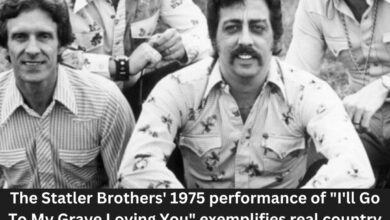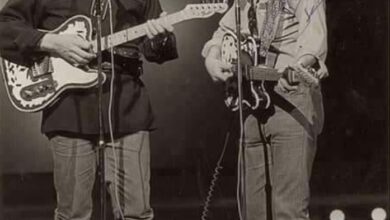Sgt. Barry Sadler’s “Ballad Of The Green Berets” Provides An Inspiring And Nationalistic Homage
In 1966, Staff Sergeant Barry Sadler emerged as a significant figure in American music with the release of “The Ballad of the Green Berets.” This song quickly became a patriotic anthem that captured the sentiments of a nation embroiled in the controversies of the Vietnam War. With its stirring lyrics, the song paid homage to the bravery and dedication of the U.S. Army Special Forces, known as the Green Berets. The simplicity of its message and the emotional weight behind it helped the song resonate with a diverse audience, including both soldiers and civilians feeling the strain of a society divided over the war.
Sadler’s own experiences in Vietnam were pivotal in shaping the song’s narrative. Serving as a medic, he was ingrained with firsthand knowledge of the sacrifices and challenges faced by the troops. This lent a level of authenticity to his work that many artists struggle to achieve. The song’s portrayal of heroism and resilience not only honored those who served but also offered a counter-narrative to the burgeoning anti-war sentiments of the era. Sadler’s ability to encapsulate the essence of military duty in music struck a chord with listeners across the nation, leading to its remarkable success on the Billboard Hot 100, where it dominated the charts for five consecutive weeks.
The chart-topping success of “The Ballad of the Green Berets” led to a rapid transformation in Sadler’s life. From a relatively obscure soldier-turned-singer, he found himself thrust into the spotlight. Appearances on popular television shows such as The Ed Sullivan Show introduced him to a larger audience, allowing him the opportunity to communicate his message of pride and valor to viewers who may not have directly experienced the war. However, the intense scrutiny and expectations accompanying sudden fame often carry burdens, and this was no different for Sadler, who struggled to replicate his initial success in subsequent musical endeavors.
Following the initial acclaim, Sadler faced a challenging juncture. His later musical releases did not achieve the same level of commercial success, leading him to explore alternative paths. He engaged in acting and attempted various business projects in a bid to sustain his livelihood. The transition from a celebrated songwriter to an artist in search of identity can be fraught with difficulties, particularly for someone whose initial success was so tied to a specific cultural moment.
Simultaneously, Sadler embarked on a writing career, creating a series of novels featuring the character Casca Rufio Longinus. These works illustrated his fascination with themes of heroism, immortality, and sacrifice, similar to those found in his music. While primarily regarded as pulp fiction, the Casca series developed a cult following. Sadler’s writings allowed him to delve into narratives that intertwined historical events with imaginative storytelling, offering readers an alternate perspective on the complexities of human existence and conflict.
Tragedy struck Sadler’s life in 1978 when a violent encounter resulted in the death of songwriter Lee Emerson Bellamy, ultimately leading to Sadler being convicted of manslaughter. This legal turmoil had a devastating impact on both his personal life and professional trajectory, introducing a depth of struggle that contrasted sharply with the earlier image he cultivated as a proud soldier and singer. Seeking an escape from the memories of his life in the U.S., Sadler relocated to Guatemala, where he continued his writing and attempted to contribute positively to the local populace, employing his medical training to help those affected by civil strife.
Yet, the challenges did not cease; in 1988, Sadler suffered a grave injury during a robbery, which left him quadriplegic after being shot in the head. The ramifications of this event were profound, altering not only his physical capabilities but also his mental state as he faced the realities of living with a debilitating condition. The vibrancy of his earlier years was overshadowed by his struggle for survival and the daunting road of rehabilitation that lay ahead. This latest tragedy starkly illustrated the fragility of life, especially for someone whose identity was so closely linked to notions of strength and freedom.
Despite these hardships, Sadler’s legacy remained intact. “The Ballad of the Green Berets” continued to be performed and honored at military functions, serving as a poignant reminder of the sacrifices made by servicemen and women throughout American history. Over time, the song evolved into a cultural artifact of the Vietnam era, embodying the complexities of war and the differing sentiments it invoked among the public. The song facilitated reflection on veteran experiences, framing the dialogue around patriotism and empathy towards those who serve.
Sadly, Barry Sadler passed away in 1989, but the impact of his work continues to resonate. His music, particularly “The Ballad of the Green Berets,” is still played and remembered at various commemorative events, serving as a means of honoring military personnel and their stories. The complexities of his life, which included both a rise to fame and a series of personal tragedies, invite important discussions around the consequences of war, the portrayal of soldiers in popular culture, and how society grapples with the narratives surrounding conflict.
The contrasting elements of Sadler’s life—his glorification of military service through music and his own personal struggles with violence and adversity—help foster dialogue about the dualities of heroism and vulnerability. His contributions invite audiences to consider not only the honor associated with military service but also the human experiences that soldiers endure both during and after their time in combat. In this way, Barry Sadler’s life and career present a compelling testimony to the complexities surrounding patriotism, identity, and the stories that soldiers carry with them.





